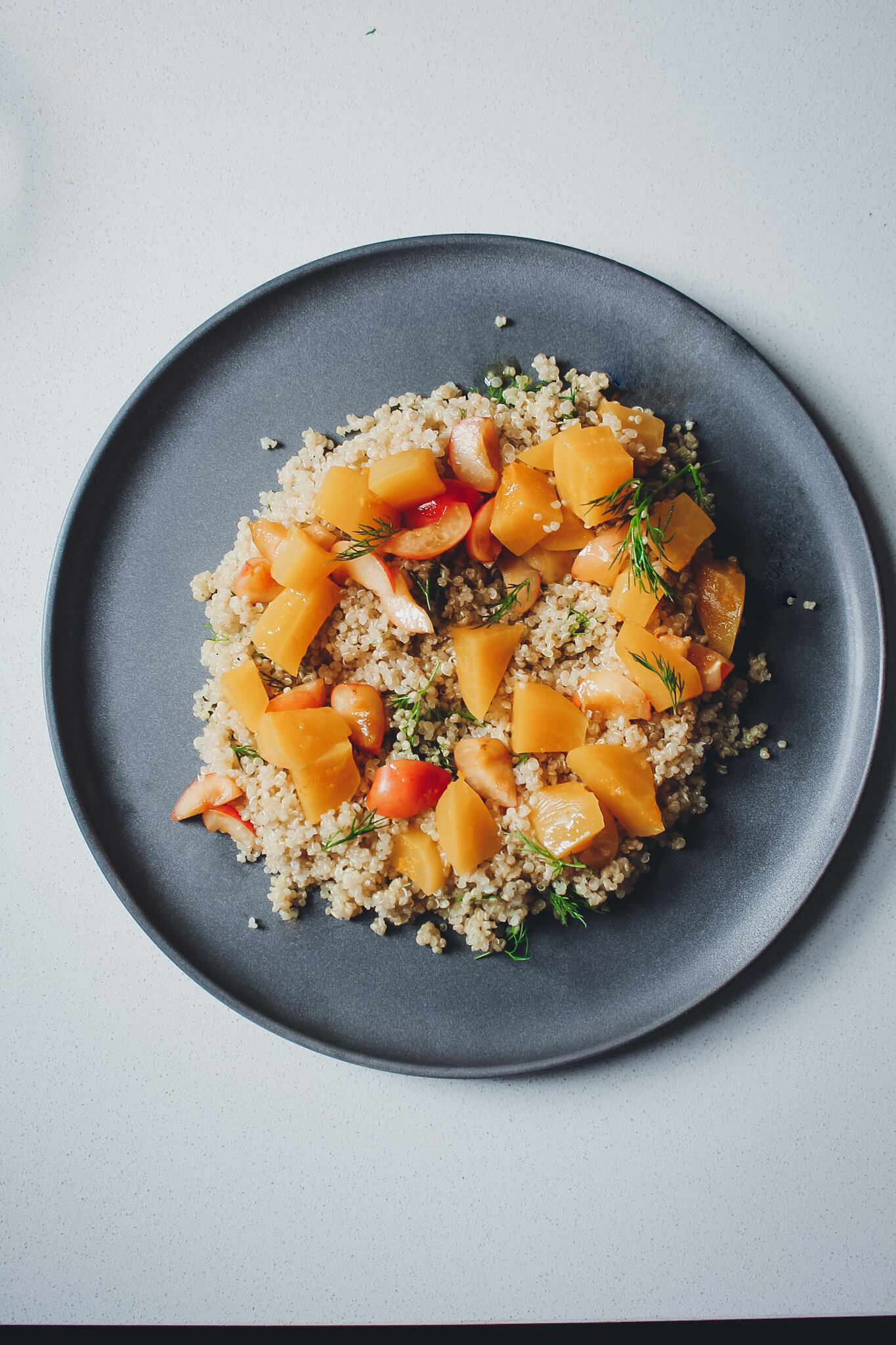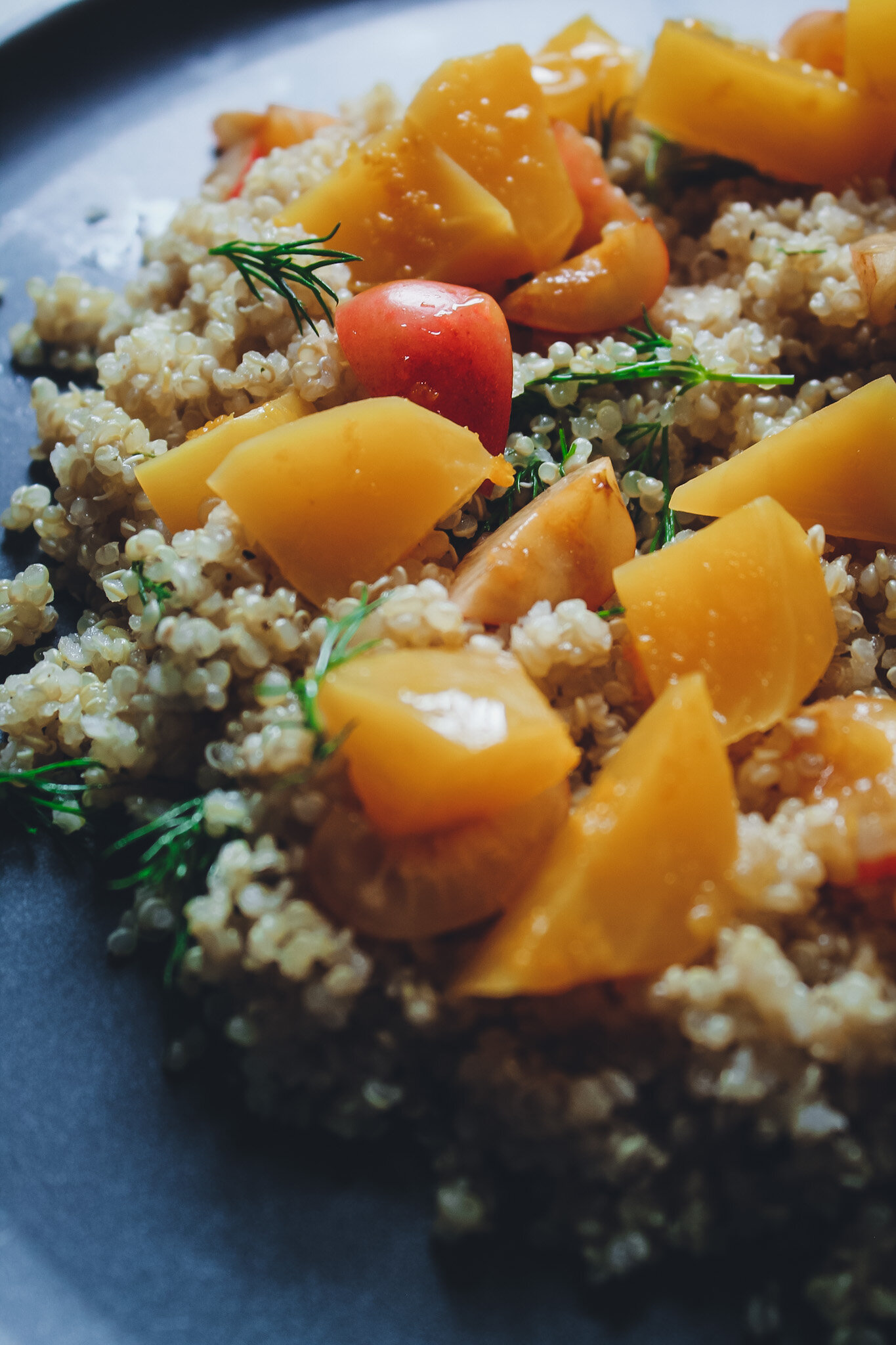Quinoa Beet Salad
June 17, 2020
Wondering what to make on a hot day?
This cold quinoa and beet salad is such a great option for eating on-the-go. Take it on picnics, road trips, to the beach, or wherever you’ll be hanging out this summer.
The combination of the orange-infused beets, sweet cherries, fresh dill, and nutty quinoa is so delicious! What’s even better is that this salad is super simple to put together. You can even make a big batch and save it for a few meals during the week, just don’t mix in the dressing until you’re about to eat it. We use golden beets here, but you can use red beets if you prefer.

Cold salads are one of the many ways you can use quinoa—a super nutritious ancient pseudocereal that is a staple in any whole food diet!
What is Quinoa?
Quinoa is a pseudo-cereal, not a grain. This just means it comes from a plant that isn’t a grass, but which has seeds that are used and eaten like cereals. Quinoa is native to the Andean region of South America and is grown in over 50 countries; the largest producers being Peru and Bolivia. Since it’s higher in nutrients than most grains, it’s often labeled as a “superfood” and has rapidly grown in popularity for its health benefits. Although technically not a grain, it’s considered a whole grain food. There are 3 main varieties: white, red, and black. It’s also becoming super popular because it’s naturally gluten-free and super versatile.
Nutritional Benefits of Quinoa
Quinoa is a fantastic source of plant-based protein. It’s a complete protein, as it contains all 9 essential amino acids. It’s also much higher in fiber than most grains and is a rich source of manganese and phosporous. Quinoa contains high amounts of plant antioxidants like quercetin and kaempferol, which have been shown to have anti-inflammatory, anti-viral, anti-depressant, and anti-cancer properties. Quinoa also has a low glycemic index, which is good for blood sugar control.
Use quinoa in breakfast porridges, soups, stews, sautées, and even desserts. There are so many possibilities!

Recipe video:
Quinoa Beet Salad
Serves 2
Quinoa
173 g quinoa, soaked overnight
450 ml water or kombu broth
5g sea salt
Beets
2 medium golden beets, peeled & medium diced
80 g freshly-squeezed orange juice (about 1 orange)
40 g white wine, rosé, or water
zest of 1 orange
zest of 1 lemon
5 g sea salt
15 g maple syrup or agave
Vinaigrette
80 g freshly squeezed orange juice
55 g extra-virgin olive oil, or Half of (leftover liquid + orange juice)
1 tsp white wine vinegar
sea salt, to taste
5 g dijon mustard
Toppings
Small handful fresh Dill, leaves picked
Freshly ground black pepper, to taste
15 Fresh cherries, pitted and quartered
Directions:
QUINOA:
-
Drain and rinse the soaked quinoa well. Place all ingredients in a medium pot and bring to a boil. Lower to a simmer and cook for 10 minutes, or until quinoa is soft and cooked through.
-
Line a baking sheet with parchment paper. Strain the quinoa to discard any remaining water and tip out on to baking sheet to cool.
BEETS:
-
In a medium pot, place the beets, orange juice, wine, citrus zests, salt, and maple syrup. Cook, covered, on low flame for 25-35 minutes, or until a toothpick inserted into the center of the beets goes through. There should still be a tiny bit of resistance—we don’t want the beets to be too soft and fall apart.
-
Drain the beets using a sieve, collecting the leftover liquid in a bowl. You’re going to use this liquid for your vinaigrette. Weigh it using a kitchen scale and take note of the amount.
VINAIGRETTE:
-
Add orange juice to the bowl with your leftover beet cooking liquid. Now add half of that mixture in olive oil (so if you had 30g leftover cooking liquid and added 80g of orange juice, that’s 110g liquid total. You’d add half of that—55g—of oil here).
-
Add vinegar and whisk. Taste and season with salt. It will separate and that’s normal, just make sure to whisk before adding to your salad.
PLATING:
-
In a large bowl, add cooked quinoa, some of the vinaigrette, some black pepper, and dill. Mix to combine. Taste for seasoning and add more vinaigrette if necessary. Add some spoonfuls of quinoa to each plate and top with beets, cherries, and more dill.
NOTE: If storing salad for a later day, don’t mix in the dressing. Add only when you’re about to eat it.
be the first to comment